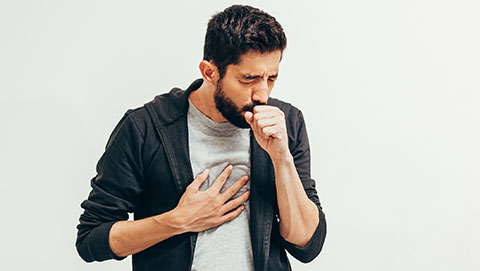
A new client calls for a manual lymph drainage session, and they have a diagnosis the massage therapist has never heard of—toxic mold syndrome. Information online about this condition is confusing and inconsistent. What is toxic mold syndrome? Does it even exist? Why is it so controversial? And most of all, what can we do to help this client?
Resources:
Edmondson, D. A. “Allergy and ‘Toxic Mold Syndrome.’ ” Annals of Allergy, Asthma & Immunology 94, no. 2 (2005): 234–39. https://doi.org/10.1016/S1081-1206(10)61301-4.
Huang, Shih-Wen. “Mold Allergy.” Last modified December 2, 2020. https://emedicine.medscape.com/article/887374-overview.
Johns Hopkins Medicine. “Multiple Chemical Sensitivity.” Accessed February 12, 2021. www.hopkinsmedicine.org/health/conditions-and-diseases/multiple-chemical-sensitivity.
Leonard, Jayne. “Black Mold Exposure: Symptoms, Treatment, and Prevention.” September 18, 2019. www.medicalnewstoday.com/articles/323419.
Pityn, Peter and James Anderson. “Misperceptions: Let’s Take the Myth-stery Out of Mold.”
Accessed February 12, 2021. www.ciphi.on.ca/images/stories/pdf/resources/healthyenvironments/PitynAndersonCIPHI_Sem_Feb_8_2017.pdf.
Poison Control. “Mold 101: Effects on Human Health.” Accessed February 16, 2021. www.poison.org/articles/2011-oct/mold-101-effects-on-human-health.
WebMD. “Allergy Major Cause of ‘Toxic Mold Syndrome.’ ” February 24, 2005. www.webmd.com/allergies/news/20050224/allergy-major-cause-toxic-mold-syndrome.
WebMD. “What is Multiple Chemical Sensitivity?” Accessed February 12, 2021. www.webmd.com/allergies/multiple-chemical-sensitivity.
Werner, Ruth. “Fungal Vocabulary.” June 28, 2019. https://youtu.be/0CfsC-8njWA.
Werner, Ruth. “Mycoses Abounding.” Massage & Bodywork magazine, July/August 2019, page 36. www.abmp.com/textonlymags/article.php?article=2068.
World Health Organization. “Mycotoxins.” May 9, 2018. www.who.int/news-room/fact-sheets/detail/mycotoxins.


This podcast sponsored by:
About Anatomy Trains:
Anatomy Trains is a global leader in online anatomy education and also provides in-classroom certification programs forstructuralintegration in the US, Canada, Australia, Europe, Japan, and China, as well as fresh-tissue cadaverdissectionlabs and weekend courses. The work of Anatomy Trains originated with founder Tom Myers, who mapped the human body into 13 myofascial meridians in his original book, currently in itsfourthedition and translated into 12 languages. The principles of Anatomy Trains are used by osteopaths,physicaltherapists,bodyworkers,massagetherapists,personaltrainers,yoga,Pilates,Gyrotonics,and other body-minded manual therapists and movement professionals. Anatomy Trains inspires these practitioners to work with holistic anatomy in treating system-wide patterns to provide improved client outcomes in terms of structure and function.
Website:anatomytrains.com
Email:info@anatomytrains.com
Facebook:facebook.com/AnatomyTrains
Instagram: instagram.com/anatomytrainsofficial
YouTube:www.youtube.com/channel/UC2g6TOEFrX4b-CigknssKHA
About Color Up:
Color Up makes 100% natural, cruelty-free, and small batch hemp-derived CBD products intended to balance the mind, body, and spirit. Color Up describes our mission, our intention, and our values. It’s a symbol of health and wellness, a way to find balance and harmony, and a way to stay connected to Mother Earth and all her colorful offerings. All Color Up products aim to evoke the body’s natural ability to heal and balance. Our process begins with the proper care and study of the cannabis plant, and extends to our therapists, chemists, and cultivators who work alongside one another to create these intentional, healing products. Color Up formulations are crafted with deliberate, complementary ingredients, working with the body’s chemistry to bring relief, correction, and homeostasis.
Website: colorupco.com
Email: info@colorupco.com
Phone: 720-420-1734
Facebook: facebook.com/ColorUpTribe
Instagram: instagram.com/colorupcbd
0:00:00.1 Ruth Werner: Ruth Werner's best-selling book, A Massage Therapist's Guide to Pathology, is a highly-regarded comprehensive resource that sets the standard for pathology education. Written for massage therapy students and practitioners, this groundbreaking resource serves up a comprehensive review of the pathophysiology, signs, symptoms and treatment of more than 500 diseases and disorders. Learn more at booksofdiscovery.com.
0:00:31.7 RW: ABMP members receive 10% off 2021 pricing on the Color Up Cannabis Master Program core classes, and receive $150 in complementary products with the program. This online course is designed for professionals to learn about CBD, the endocannabinoid system, and why bringing CBD body care and even skin care into your practice is more than just a trend. It's a comprehensive approach to functional healing for body, mind and spirit. Color Up makes it easy and affordable to introduce Color Up's professional spa products into your practice. ABMP members access your special promo codes by logging into your ABMP member discounts page at abmp.com/discounts or visit colorupco.com to learn more.
[music]
0:01:33.1 RW: Hi, and welcome to "I Have a Client Who... " Pathology Conversations with Ruth Werner, the podcast where I will discuss your real-life stories about clients with conditions that are perplexing or confusing. I'm Ruth Werner, author of A Massage Therapist's Guide to Pathology, and I have spent decades studying, writing about, and teaching about where massage therapy intersects with diseases and conditions that might limit our client's health. We almost always have something good to offer, even with our most challenged clients, but we need to figure out a way to do that safely, effectively and within our scope of practice. And sometimes, as we have all learned, that is harder than it looks.
0:02:20.0 RW: Today's story comes from a massage therapist who shared a question on one of my very favorite Facebook pages, the Massage Sloth clubhouse. It's not really an "I have a client who" story, but it is an "I'm going to have a client who" story, and it goes like this: "Has anyone here worked on someone with toxic mold syndrome and chronic inflammation? I got a voicemail from someone whose doctor suggested manual lymph drainage. I can definitely do that, I just haven't encountered it before." So with this person's permission, I thought this might be an interesting subject to explore here on "I Have a Client Who... " And then I started gathering information on toxic mold syndrome, and I discovered that this is one of those topics that appears to be strongly polarizing. So I'm gonna share some information from sources that I think are really credible, and I'll talk about why some other sources are worthy of some deeper scrutiny. And then of course, we will talk about options for this massage therapist whose client is clearly having a hard time, and who deserves to feel better.
0:03:31.0 RW: So let's start with this: Mold is everywhere. Most exposure to molds happens out of doors, but there are lots of indoor molds as well, of course. Molds really like human environments, but exposure to mold in the environment does not rely on humidity. There are instances where areas going through extreme drought have elevated levels of mold spores in the air, which might be associated with some physiologic responses. Molds are not the same as fungi, but they are a sub-group of fungi, that is to say all molds are fungi, but not all fungi are molds. Fungi also include organisms like lichens, mushrooms, truffles, yeasts, and some other things.
0:04:16.2 RW: Some molds produce materials that are toxic to humans, these are called mycotoxins. Some mycotoxins are produced by molds that grow on foods, and these can be dangerous to humans and other animals. Aflatoxins are produced by molds on some cereals and other foods, and these can cause liver damage, for instance. On the other hand, some molds have been used in medications. You may be aware that bread mold was the first source of penicillin. Some molds that grow indoors, not on food, can produce mycotoxins that seem to illicit inflammatory or allergic responses, but these are not generally accepted as disease-causing organisms in the same way that we don't consider cat dander or ragweed pollen to be disease-causing substances; but our allergic reactions definitely interfere with our function.
0:05:09.5 RW: The species that is identified as black mold is called Stachybotrys chartarum, and this makes ugly and scary-looking colonies on building materials; and left untreated, it can eventually weaken a building's structure, which is one reason we use mold mitigation experts to deal with it. The other, of course, is that some people have negative reactions to it and other molds that are found in buildings. After decades of study, it is still not clear how or how often mold on or in buildings, black and otherwise, causes changes in human function. Scientists have classified some ways this might happen. We can see harmful and extreme allergic responses, which sometimes, leads to hypersensitivity pneumonitis, and I'll get back to that in a minute. They can cause infections where mold spores actually enter the body and set up colonies, and I'll talk about that, too. And we can see simple irritation and toxicity from those mycotoxins.
0:06:12.8 RW: So before we take this any further, I wanna just do a quick detour to talk about hypersensitivity pneumonitis. As you can derive from the name, this has to do with lung inflammation, pneumonitis, due to hypersensitivity, which is to say some kind of allergic reaction. Usually, we don't think of allergies causing serious, long-term structural changes in the body; but in some cases, this is a possibility, and hypersensitivity pneumonitis is a set-up for another thing called pulmonary fibrosis. That's the growth of permanent, progressive scar tissue in the lungs, and this can be a life-shortening problem. I don't wanna be alarmist here, and this is not what we hear about in the context of toxic mold syndrome, but chronic lung problems caused by mold and other things can be really serious. I have an article coming up in the March-April 2021 edition of Massage & Bodywork on pulmonary fibrosis. So if this is of special interest to you, you'll wanna check this out.
0:07:17.7 RW: I also wanna bring up the risk of mold or fungal infections within the respiratory system. These are especially threatening to people with impaired immune system function, and they can be very difficult to treat. Some of them are really resistant to medical treatment. Again, we don't see people being colonized with Stachybotrys chartarum, but some other molds and fungi can take up residence and cause these stubborn infections. I wrote another article on this topic called Mycoses Abounding in the July-August 2019 edition of Massage & Bodywork. And the video that accompanies this article has, if I say so myself, a rather lovely poem about fungal vocabulary, so check it out.
0:08:02.7 RW: Our techniques for measuring levels of mold or spores in the air are not very sensitive, which is one reason there's a level of skepticism about how often these reactions are actually caused by mold or spores or mycotoxins, or whether they might be related to any of the dozens of other potentially irritating substances that can abound in a poorly-ventilated indoor environment. By the way, this situation with harmful physiologic reactions in indoor areas has given rise to some other labels you might have heard of like sick building syndrome or damp building syndrome. But what is the line between normal, unavoidable levels of fungi or mold in an environment, and having those levels be high enough to make someone sick? We don't have good ways to measure this problem, and it doesn't help that there are inconsistencies and guidelines about mold exposures, health effects, remediation and prevention coming from various government organizations like the Centers for Disease Control and OSHA and some others.
0:09:10.7 RW: Mold mitigation in buildings is big business, and treatment for mold-related illnesses is also big business. I was unable to find information about toxic mold syndrome treatment from any source that wasn't selling products or services, and to me, that's a red flag. We have to be wary of claims about mold toxicity coming from people who have a financial stake in our actions. Please don't hear this as, "Ruth says there's no such thing as toxic mold syndrome, and this client isn't really sick," because that is not what I'm saying. But I do wanna be sure to be as accurate as possible, and at this time, the evidence doesn't support black mold as being a significant source of human illness. Allergic reactions to it can be, for sure, but that's a slightly different thing, as I hope you can see.
0:10:02.9 RW: Before we turn back to talk about this client, I wanna share this from a website called poison.org, which is produced by the National Capital Poison Center. They say, this is a quote, "Toxic mold syndrome is a legal construct, rather than a medical diagnosis, involving unidentified disease processes, a constellation of disparate symptoms, and reports of illness uncorroborated by a physical examination of the patients or a professional examination of their surroundings. Although black mold or toxic mold has been identified in litigation as a cause of human illness, there is no established cluster of symptoms or physical findings associated with this alleged disease. There are neither diagnostic criteria, nor any valid scientific publications establishing Stachybotrys or other molds as a cause of these diverse symptoms."
0:11:02.3 RW: Okay, let's put this aside for right now, and let's just talk about how we might help this client who doesn't feel good, and who deserves to feel better. Regardless of the costs, people who have these kinds of reactions are having a hard time. These inflammatory or toxicity reactions can look like typical respiratory allergies with runny nose, and itchy eyes, and asthma, coughing, wheezing, shortness of breath. If the sinuses have become congested, then we might see headaches and migraines. All of these symptoms can be persistent, they can lead to loss of sleep, which of course, opens the doors to a ton of other problems, and the whole thing can really wreck a person's quality of life. And in some cases, the patients seem to have non-respiratory symptoms, too, including neurological issues like restless leg syndrome, dizziness, anxiety, memory loss, and mental fogginess, and some people have GI tract problems like nausea, vomiting and diarrhea.
0:12:06.9 RW: It may be a matter of semantics, whether we call this client situation toxic mold syndrome as a distinct disease process, or a really severe, even dangerous, allergy. Yet another factor at play here might be a condition called multiple chemical sensitivity syndrome. In this situation, a history of exposure to some kind of trigger sets up an immune system response that becomes more and more sensitive to more and more triggers. So we don't know a lot about this client, other than that her doctor, and we don't know if this is a medical doctor, a naturopath, an osteopath, or someone else, but her doctor suggested that she get manual lymphatic drainage. And this recommendation relies on her being free of some kind of infection that might be spread by this kind of work. Other than that, what is a realistic expectation of MLD in a client with toxic mold syndrome, whatever that really is?
0:13:08.0 RW: Well, I'm happy to say that the realistic expectation for this situation is pretty good. MLD is terrific for relieving congestion in the lymphatics, in the sinuses, and in ways that can help people who are having respiratory symptoms and other kinds of swelling to feel much better. It was interesting to note in the thread on this topic in the Massage Sloth clubhouse, how many people contributed that MLD helped them with all of their allergy-related discomforts. Will manual lymphatic drainage cure this client of toxic mold syndrome? Yeah, probably not. But if this intervention, in combination with avoiding the triggers of her reactions, and taking other steps to promote good health and resilience, if all of this helps her to return to some kind of good quality of life, we call that success.
0:14:01.0 RW: Given that this client is probably extremely sensitized to environmental irritants, I highly recommend that this massage therapist do an audit of her workspace in order to remove anything that might elicit some kind of hypersensitivity reaction. And this would include things like candles or air fresheners or incense. We wanna leave lots of time to air out the room thoroughly from the previous client, just in case there's someone who smells like cigarette smoke, or they wear a lot of perfume, or have some other kind of scent. We wanna be sure to use a hypoallergenic lubricant. And we wanna be sure that the linens don't smell like fabric softener or bleach or detergent. Do you have other ways that you make your session room allergy-friendly? I'd love to know about them, so be sure and let me know. I'm excited for this massage therapist and her new client, and I anticipate that their work together will lead to some positive outcomes. If I hear otherwise, I'll be sure to let you know in a future episode.
0:15:01.0 RW: Hey, everybody, thanks for listening to "I Have a Client Who... " Pathology Conversations with Ruth Werner. Remember, you can send me your "I have a client who" stories to ihaveaclientwho@ABMP.com. That's ihaveaclientwho, all one word, all lowercase, at A-B-M-P dot com. I can't wait to see what you send me, and I'll see you next time.
[music]
0:15:29.0 Speaker 2: Anatomy Trains is excited to invite you to a new, Two-Day Dissection Livestream Specialty Class, The Deep Front Line and the Central Nervous System, February 27th and 28th. This advanced dissection livestream educational experience is presented by Tom Myers and Todd Garcia, together in the lab for the first time in a year. In four two-hour sessions, we will explore detailed anatomy and the fascial connections in the ventral core, what Tom Myers termed "the deep front line", moving on to the brain, spinal cord and fascial membranes that surround the central nervous system in the dorsal cavity. This special dissection livestream format allows us to explore more deeply subjects in areas of interest. Visit anatomytrains.com for details.